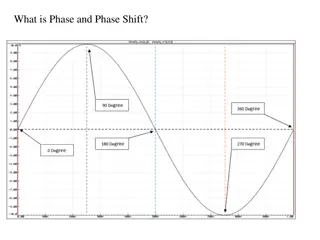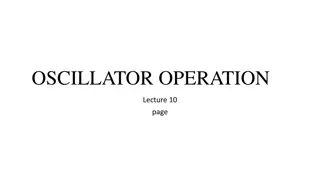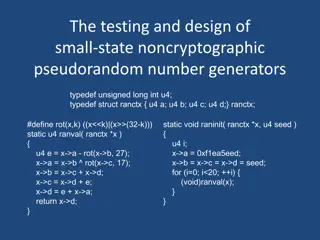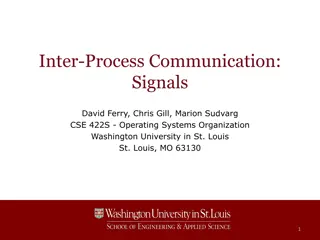Understanding Signal Generators and Oscillators in Electrical Testing
Signal generators and oscillators are essential sources of electrical signals for testing various equipment. Fixed and variable AF oscillators play a key role in generating different waveforms. Fixed frequency oscillators provide signals within specified ranges, while variable oscillators cover the entire audio frequency range. Learn about their types, applications, and functionalities in electrical testing.
Download Presentation

Please find below an Image/Link to download the presentation.
The content on the website is provided AS IS for your information and personal use only. It may not be sold, licensed, or shared on other websites without obtaining consent from the author. Download presentation by click this link. If you encounter any issues during the download, it is possible that the publisher has removed the file from their server.
E N D
Presentation Transcript
Unit-3 s
Fixed and Variable AF Oscillator Signal generators are the sources of electrical signals used for the purpose of testing and operating different kinds of electrical equipment. A signal generator provides different types of waveforms such as sine, triangular, square, pulse etc., whereas an oscillator provides only sinusoidal signal at the output. The AF oscillators are divided into two types. They are as 1. Fixed frequency 2. Variable frequency follows oscillator AF AF oscillator.
1. Fixed Frequency AF Oscillator: Many instrument circuits contain oscillator as one of its integral parts to provide output signal within the specified fixed audio frequency range. This specified audio frequency range can be 1 kHz signal or 400 Hz signal. The 1 kHz frequency signal is used to execute a bridge circuit and 400 Hz frequency signal is used for audio testing. A fixed frequency AF oscillator transformer. Due to this a positive feedback is obtained through the inductive coupling placed between the primary winding and secondary winding of the transformer and hence fixed frequency oscillations are generated. employs an iron core
2. Variable It is a general purpose oscillator used in laboratory. It generates oscillations within the entire audio frequency range i.e. from 20 Hz to 20 kHz. This oscillator provides a pure, constant sine wave output throughout this AF range. The examples of variable AF oscillators used in laboratory are RC feedback oscillator, beat frequency oscillator. Frequency AF Oscillator:
The front panel of a signal generator consists of the following. Frequency selector : It selects the frequency in different ranges and varies it continuously in a ratio of 1 : 11. The scale is non- linear. Frequency multiplier It selects the frequency range over 5 decades, from 10 Hz to 1 MHz. Amplitude multiplier It attenuates the sine wave in 3 decades, x 1, x 0.1 and x 0.01. Variable amplitude It attenuates the sine wave amplitude continuously. Symmetry control It varies the symmetry of the square wave from 30% to 70%. Amplitude It attenuates the square wave output continuously. Function switch It selects either sine wave or square wave output. Output available This provides sine wave or square wave output. Sync This terminal is used to provide synchronisation of the internal signal with an external signal. 10. On-Off Switch 1. 2. 3. 4. 5. 6. 7. 8. 9.
SQUARE AND PULSE GENERATOR: They provide both quantitative and qualitative information of the system under test. They are made use of in transient response testing of amplifiers. The fundamental difference between a pulse generator and a square wave generator is in the duty cycle. A square wave generator has a 50% duty cycle. used as measuring devices in combination with a CRO.
Requirements of a Pulse The pulse should have minimum distortion. The basic characteristics of the pulse are rise time, overshoot, ringing, sag, and undershoot. The pulse should have sufficient maximum amplitude. The range of frequency control of the pulse repetition rate (PRR) should meet the needs of the experiment. For example: a repetition frequency of 100 MHz is required for testing fast circuits. Other generators have a pulse-burst feature which allows a train of pulses rather than a continuous.
Requirements of a Pulse Contd. Some pulse generators can be triggered by an externally applied trigger signal; conversely, pulse generators can be used to produce trigger signals, when this output is passed through a differentiator circuit. The output impedance of the pulse generator is another important, In a fast pulse system, the generator should be matched to the cable and the cable to the test circuit. A mismatch would cause energy to be reflected back to the generator by the test circuit, and this may be re-reflected by the generator, causing distortion of the pulses. DC coupling of the output circuit is needed.
A laboratory type square wave and pulse generator is shown in Fig. 8.6.
RANDOM NOISE GENERATOR: The instrument offers the possibility of using a single measurement to indicate performance over a wide frequency band, instead of many measurements at one frequency at a time. The spectrum of random noise covers all frequencies and is referred to as White noise, i.e. noise having equal power density at all frequencies (an analogy is white light).
RANDOM NOISE GENERATOR Contd. The method of generating noise is usually to use a semi conductor noise diode, which delivers frequencies extending from 80 220 kHz. The output from the noise diode is amplified and heterodyned down to the audio frequency band by means of a balanced symmetrical modulator. The filter arrangement controls the bandwidth and supplies an output signal in three spectrum choices, white noise, pink noise and USASI noise. in a band roughly
RANDOM NOISE GENERATOR Contd. It is seen that white noise is flat from 20 Hz to 25 kHz and has an upper cutoff frequency of 50 kHz with a cutoff slope of 12 dBs/ octave. Pink noise is so called because the lower frequencies have a larger amplitude, similar to red light. Pink noise has a voltage spectrum which is inversely proportional to the square root of frequency and is used in bandwidth analysis. Usasi noise ranging distribution of speech and music frequencies and is used for testing audio amplifiers and loud speakers. simulates the energy
SWEEP GENERATOR: It provides a sinusoidal output voltage whose frequency varies smoothly and continuously over an entire frequency band, usually at an audio rate. The process of frequency modulation is done electronically by using the modulating voltage to vary the reactance of the oscillator tank circuit component, and mechanically by means of a motor driven capacitor, as provided for in a modern laboratory type signal generator.























